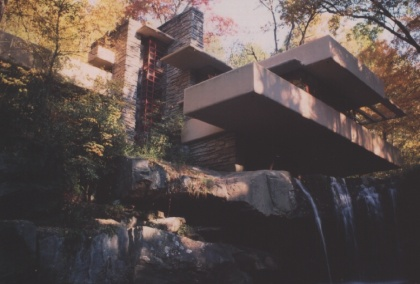 |
||||
|
F R A N K L L O Y D W R I G H T'S "F A L L I N G W A T E R" |
||||
| A couple of years ago the American Institute of Architects published a paper which rated the one hundred "Most Influential Buildings in the History of the World." The organization rated them in order from the most influential to the one hundredth. Every great building in the world was on this list. | ||||
| RATED AS THE MOST INFLUENTIAL BUILDING OF ALL TIME
WAS:
FRANK LLOYD WRIGHT'S "FALLINGWATER"! |
||||
|
This building was rated ahead of the Taj Mahal, The Parthenon, the great Gothic churches of France, Westminster Cathedral, the best buildings of the Renaissance, all the finest buildings which have been constructed since, as the building which has had the most influence upon architecture. It was as if, now that Frank Lloyd Wright had set the limits so high, nothing could now be forbidden the creative architect. And, people wanting to live in houses no longer had to be content with the box house that most reside in, that there was something different and better available. Frank Lloyd Wright had made that possible! When you think long and hard about it, it stands the test of reason: virtually everyone has seen photos of Frank Lloyd Wright's "Fallingwater", and almost all have marveled at this supreme wedding of structure and site, and wonderful sense of proportion of the parts becoming one organic whole. Upon an incomparable site in the woods, the house floats majestically and romantically above the lovely waterfall and rock shelves, it, too, being of rock and horizontal shelves of concrete, house and terraces tying into the rock cliffs behind and growing out of them. Most viewers, seeing pictures of Fallingwater for the first time, are simply amazed by it. The ones who are lucky enough to visit the site come away thinking that they would love to live there, if only for a little while. Hundreds of thousands of people visit this house each year. They drive many miles to do so, some coming from clear across the country with the main purpose of seeing Frank Lloyd Wright's Fallingwater. And they pay $8 to $12 per person just to walk around and through the house for an hour or so, feeling the space, sitting on the built-in sofa, standing on the wonderful terrace over the waterfall and looking down. Edgar Kaufmann, Jr., the son of the original owner and who lived at "Fallingwater" off and on for many years, wrote a book about it, and in his forward, he says, "Fallingwater is famous, from all over the world many thousands of visitors come each year to its remote site. What draws them?--a most unusual house in an exceptionally picturesque setting and, something more, a reputation. In 1936, even before construction was finished, knowledge-able people talked about this new work of Frank Lloyd Wright. It upset the experts' opinion that the contentious old American architect (he was then nearing seventy) had nothing of value to add to his achievements. In fact, this house and three more individually superlative buildings that went up almost simultaneously announced an entire new quarter-century of Wright's ebullient creativity. |
"Fallingwater itself was quickly and widely displayed in
exhibitions, in magazines and newspapers, and in many books. After a
time a consensus arose that Wright had created a masterwork that
appealed not only to professionals, but to the public generally.
Fallingwater was not much like the earlier architecture (I disagree with
this statement) that had made Wright famous; it was just as distant from
the avant-garde styles of the 1930s, and surely unlike any popular
'dream house.' Yet now that Fallingwater has been tested by
half-a-century of the widest exposure, one can say that it marks a high
point in Wright's vast oeuvre, in American architecture, in the
architecture of this century, and possibly in all architecture."
Mr. Kaufmann goes on to say, "...why does a house designed by an architectural individualist for the special purposes of a special client appeal so much to the public in general? And what does it contribute to the art of architecture if its character is so circumscribed? One part of the answer is that Fallingwater is a happy flowering of Frank Lloyd Wright's genius, a great work of art. Yet underneath the effects of great art--however masterly and ingenious--there lies a consistency of the whole. To understand this quality one must consider those principles that guided the artist. In Wright's statements his principles are denoted by words embodying deep intuitions: organic, democratic, plasticity, continuity. During careful study of his texts and his architecture, I have come to believe that these terms present different aspects of one central insight. To Wright, architecture was a great inclusive agency through which humankind adapted the environment to human needs and, reciprocally, attuned human life to its cosmos; amid continual changes architecture could keep human life more natural and nature more humane. This idea pervades Fallingwater in accord with the aims of both architect and client, and gives it not only basic meaning but also powerful subliminal appeal..." But, in 1936, this greatest architect we have ever had was nearing seventy years old and had all but disappeared from the architectural scene; for Frank Lloyd Wright had not had a decent building to design in twelve years. But then, in the midst of the Great Depression, came the chance to design this weekend retreat for J. Edgar Kaufmann and wife and son. Do you think that he would not have taken advantage of this chance to once again astound the world, and get his name back in the newspapers? Yes, design something that would knock their eyes out? You bet your life he would! And he did! |
|||
| 1 2 3 4 | ||||
